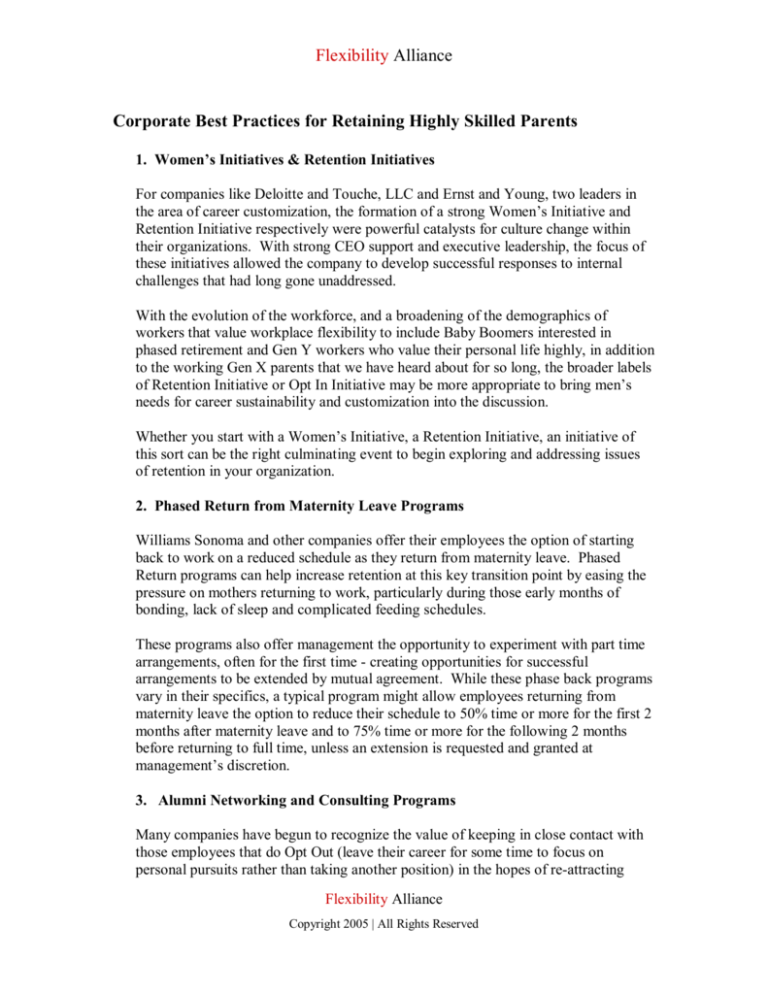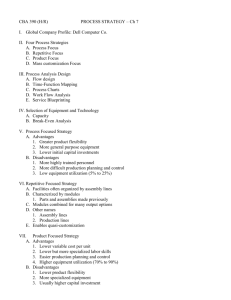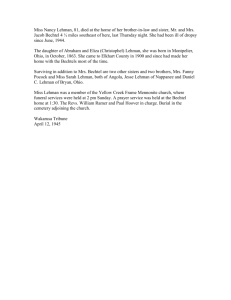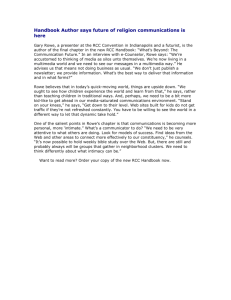
Flexibility Alliance
Corporate Best Practices for Retaining Highly Skilled Parents
1. Women’s Initiatives & Retention Initiatives
For companies like Deloitte and Touche, LLC and Ernst and Young, two leaders in
the area of career customization, the formation of a strong Women’s Initiative and
Retention Initiative respectively were powerful catalysts for culture change within
their organizations. With strong CEO support and executive leadership, the focus of
these initiatives allowed the company to develop successful responses to internal
challenges that had long gone unaddressed.
With the evolution of the workforce, and a broadening of the demographics of
workers that value workplace flexibility to include Baby Boomers interested in
phased retirement and Gen Y workers who value their personal life highly, in addition
to the working Gen X parents that we have heard about for so long, the broader labels
of Retention Initiative or Opt In Initiative may be more appropriate to bring men’s
needs for career sustainability and customization into the discussion.
Whether you start with a Women’s Initiative, a Retention Initiative, an initiative of
this sort can be the right culminating event to begin exploring and addressing issues
of retention in your organization.
2. Phased Return from Maternity Leave Programs
Williams Sonoma and other companies offer their employees the option of starting
back to work on a reduced schedule as they return from maternity leave. Phased
Return programs can help increase retention at this key transition point by easing the
pressure on mothers returning to work, particularly during those early months of
bonding, lack of sleep and complicated feeding schedules.
These programs also offer management the opportunity to experiment with part time
arrangements, often for the first time - creating opportunities for successful
arrangements to be extended by mutual agreement. While these phase back programs
vary in their specifics, a typical program might allow employees returning from
maternity leave the option to reduce their schedule to 50% time or more for the first 2
months after maternity leave and to 75% time or more for the following 2 months
before returning to full time, unless an extension is requested and granted at
management’s discretion.
3. Alumni Networking and Consulting Programs
Many companies have begun to recognize the value of keeping in close contact with
those employees that do Opt Out (leave their career for some time to focus on
personal pursuits rather than taking another position) in the hopes of re-attracting
Flexibility Alliance
Copyright 2005 | All Rights Reserved
Flexibility Alliance
them back to the organization when they are ready to return to work. Deloitte and
Touche, L.L.C.’s Personal Pursuits Program, Booz Allen Hamilton’s Adjunct
program and a new program at American Express are all excellent examples of this
model. A number of companies are implementing similar programs to maintain
close contact with valuable employees that have chosen to take time off from their
careers. Again these programs vary, but a typical program would offer employees
with consistently positive reviews who are leaving the firm, but don’t intend to seek
employment during their absence, the ability to keep their corporate email account,
continue to attend company parties and events, access free training to keep their skills
fresh, and keep aware of part time or temporary consulting opportunities with the firm
to stay engaged in their field.
At a very low cost to the firm, these programs help to communicate to valuable talent
that the company supports their decision to focus on personal goals for some time,
wants to invest in a long term relationship with them, and would welcome them back
to the firm when the time is right.
3. On Ramp Recruiting
Lehman Brothers has championed this innovative new recruiting model to re-attract
senior women that have Opted Out from the financial industry back to a career at
Lehman Brothers. Many companies including Goldman Sachs are following suit.
While these programs vary, the common thread is a concerted effort to identify top
candidates from the company’s industry that have Opted Out of their careers, and an
attempt to recruit them back into careers with the firm. Companies that are investing
in this model, find that it is having an additional benefit of branding them strongly as
employers of choice with younger MBA candidates that are interested in starting their
with a firm that is committed to supporting them through all phases of their career.
Lehman Brother’s Encore Program is currently structured as a series of targeted
regional events, where the top women who have Opted Out of their careers in the
Financial industry are invited to attend an event at Lehman Brother’s offices to learn
about the latest trends in the industry, hear from motivational speakers, and network.
Those women that are currently interested in returning to work are invited to
interview with the firm. Those that aren’t yet ready to return, are connected with one
another and members of the firm through an Encore alumni group in the hopes that
they will consider Lehman strongly when they are ready to return. In a little under a
year, Lehman has hired 15 senior women through their Encore Program. In a shorter
period, Goldman Sachs had hired 5 through their similar program.
4. Mass Career Customization
Deloitte and Touche, LLC is currently piloting a Mass Career Customization program
for their employees. The program is based in a recognition that every employee can
benefit from career control and sustainability. Deloitte’s mass career customization
program integrates career customization into standard career planning and
Flexibility Alliance
Copyright 2005 | All Rights Reserved
Flexibility Alliance
progression with the firm and institutionalizes the concept of a career lattice, rather
than a linear career ladder to prevent flexibility options from taking talent off track
for promotion.
The Mass Career Customization Program asks management to work with employees
to understand their custom career goals on 4 continua of Career Pace (advancement),
Place (travel), Role, and Schedule and work with employees to tune their custom
career path accordingly.
5. Results Oriented Work Environments (ROWE)
Best Buy developed their methodology for Results Only Work Environments in
response to employee survey results that documented dissatisfaction with work life
balance and career control among employees, resulting in high turnover. The goal of
the ROWE program is to transform the work culture at Best Buy to measure
employees primarily on work performance and allow them the freedom to decide
how, when and where they get their job done.
Rather than treating the program as a mandate, Best Buy is allowing departments or
teams to choose their timelines for migrating to this new work model. The
conversion process for new teams takes about 6 months and includes leadership
training, team training, a month and a half pilot test and a debriefing. The
productivity returns from ROWE teams have been very notable, with a 35% average
increase in productivity. The company also sees 3.2% less voluntary turnover from
ROWE teams, so the returns have been significant. Other companies interested in
exploring ROWE for their companies can reference the book, “Throwing Out the
Rules of Work”, Patrick J. Kiger, Workforce Management, September 25, 2006.
6. Part Time, Job Sharing and Other Flexibility Programs
Flexibility options include shifted full time schedules, part time, job sharing,
condensed schedules, telecommuting and others. Companies like Pfizer, with its
prized 80% quota sales force, that boasts a 120 person waiting list use flexibility as a
reward and motivator as well as a retention tool.
British Telecom in the UK has been very successful with flexibility programs and
cites more than 500 job sharing employees and more than 2500 part time workers.
Clorox in the United States has also developed a culture that supports job sharing and
part time roles in response to workers’ needs. Currently more than 10% of Clorox’s
Marketing organization is on a Part Time arrangement.
In companies or roles where coverage and access are highly valued, job sharing may
be a better fit than an individual part time arrangement. According to one Bay Area
study of 100 part time workers, the Job Sharing workers cited higher satisfaction with
their future career prospects than part time employees not working as a part of a job
sharing team.
Flexibility Alliance
Copyright 2005 | All Rights Reserved








